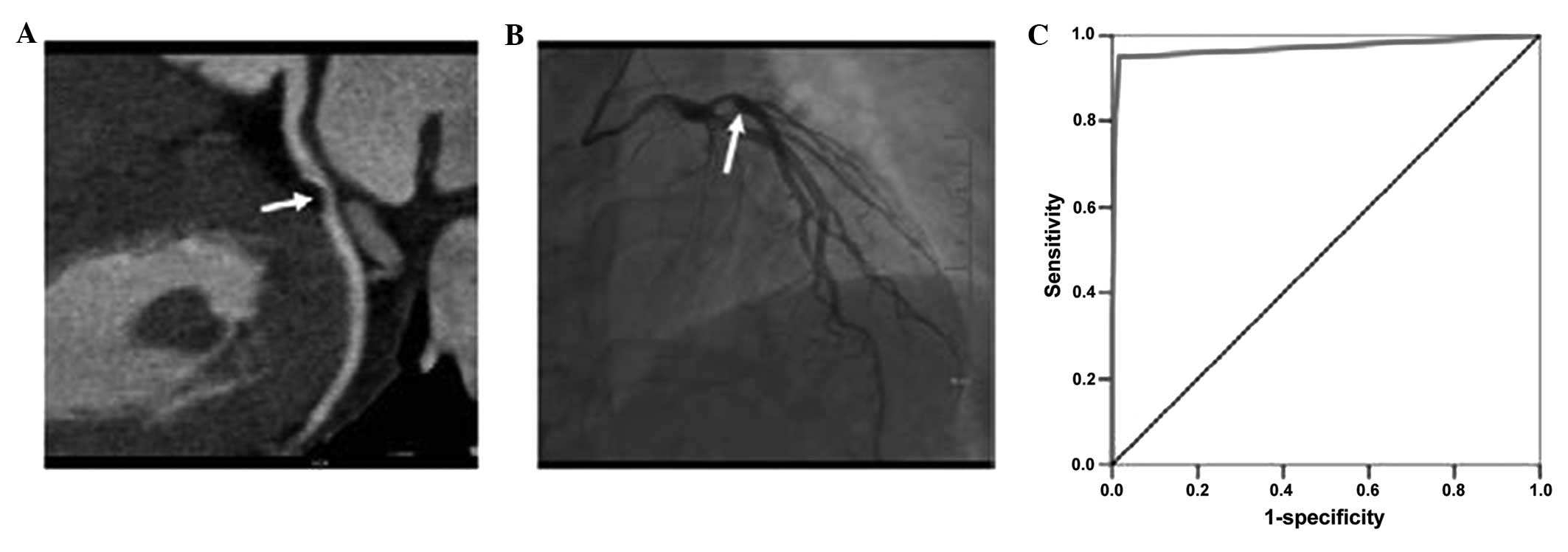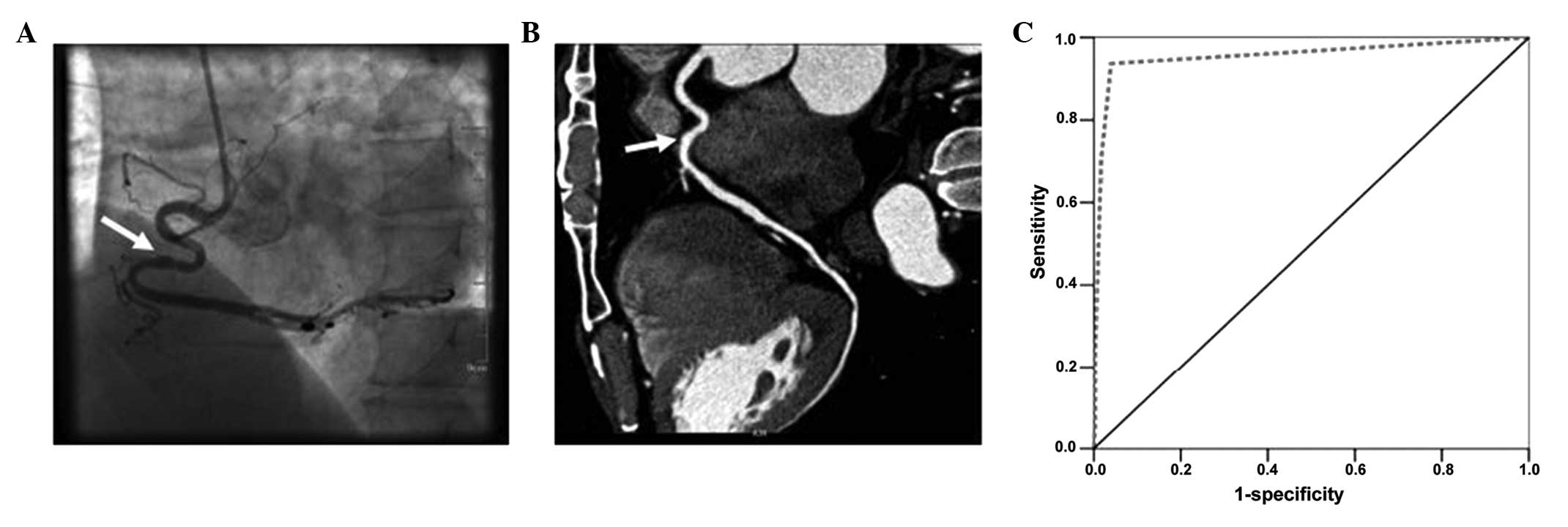|
1
|
Higuchi K, Nagao M, Matsuo Y, Kamitani T,
Yonezawa M, Jinnouchi M, Yamasaki Y, Abe K, Baba S, Mukai Y, et al:
Evaluation of chronic ischemic heart disease with myocardial
perfusion and regional contraction analysis by contrast-enhanced
256-MSCT. Jpn J Radiol. 31:123–132. 2013. View Article : Google Scholar : PubMed/NCBI
|
|
2
|
Rossi Pesenti D, Caussin C, Baron N,
Fourme T and Livarek B: Coronary graft angioplasty guided by MSCT:
An unexpected ostial stent deformation. Eur Heart J Cardiovasc
Imaging. 14:3082013. View Article : Google Scholar : PubMed/NCBI
|
|
3
|
Iino R, Yokoyama N, Konno K, Naito K and
Isshiki T: Impact of combined assessment of coronary artery calcium
score, carotid artery plaque score, and brachial-ankle pulse wave
velocity for early coronary revascularization in patients with
suspected coronary artery disease. Int Heart J. 53:154–159. 2012.
View Article : Google Scholar : PubMed/NCBI
|
|
4
|
Shelley S, Indirani M, Sathyamurthy I,
Subramanian K, Priti N, Harshad K and Padma D: Correlation of
myocardial perfusion SPECT with invasive and computed tomography
coronary angiogram. Indian Heart J. 64:43–49. 2012. View Article : Google Scholar : PubMed/NCBI
|
|
5
|
Rafiq S, Johansson PI, Zacho M, Stissing
T, Kofoed K, Lilleør NB and Steinbrüchel DA: Thrombelastographic
haemostatic status and antiplatelet therapy after coronary artery
bypass surgery (TEG-CABG trial): assessing and monitoring the
antithrombotic effect of clopidogrel and aspirin versus aspirin
alone in hypercoagulable patients: study protocol for a randomized
controlled trial. Trials. 13:482012. View Article : Google Scholar : PubMed/NCBI
|
|
6
|
Seng K, Breuckmann F, Schlosser T,
Barkhausen J, Geckeis K, Budde T, Hoefs C, Schmermund A, Erbel R
and Ladd SC: Concomitant atherosclerotic disease detected by
whole-body MR angiography in relation to coronary artery
calcification in patients with coronary artery disease. RoFo
Fortschr Geb Rontgenstr Nuklearmed. 182:334–340. 2010. View Article : Google Scholar : PubMed/NCBI
|
|
7
|
van Werkhoven JM, Heijenbrok MW, Schuijf
JD, Jukema JW, van der Wall EE, Schreur JH and Bax JJ: Combined
non-invasive anatomical and functional assessment with MSCT and MRI
for the detection of significant coronary artery disease in
patients with an intermediate pre-test likelihood. Heart.
96:425–431. 2010. View Article : Google Scholar : PubMed/NCBI
|
|
8
|
Bonello L, Armero S, Jacquier A, Com O,
Sarran A, Sbragia P, Panuel M, Arques S and Paganelli F:
Non-invasive coronary angiography for patients with acute atypical
chest pain discharged after negative screening including maximal
negative treadmill stress test. A prospective study. Int J Cardiol.
134:140–143. 2009. View Article : Google Scholar : PubMed/NCBI
|
|
9
|
Yoshida H, Yokoyama K, Maruvama Y,
Yamanoto H, Yoshida S and Hosoya T: Investigation of coronary
artery calcification and stenosis by coronary angiography (CAG) in
haemodialysis patients. Nephrol Dial Transplant. 21:1451–1452.
2006. View Article : Google Scholar : PubMed/NCBI
|
|
10
|
Hersberger M, Muntwyler J, Funke H,
Marti-Jaun J, Schulte H, Assmann G, Lüscher TF and von Eckardstein
A: The CAG repeat polymorphism in the androgen receptor gene is
associated with HDL-cholesterol but not with coronary
atherosclerosis or myocardial infarction. Clin Chem. 51:1110–1115.
2005. View Article : Google Scholar : PubMed/NCBI
|
|
11
|
Klass O, Walker M, Siebach A, Stuber T,
Feuerlein S, Juchems M and Hoffmann MH: Prospectively gated axial
CT coronary angiography: Comparison of image quality and effective
radiation dose between 64- and 256-slice CT. Eur Radiol.
20:1124–1131. 2010. View Article : Google Scholar : PubMed/NCBI
|
|
12
|
Budoff MJ, Achenbach S, Blumenthal RS,
Carr JJ, Goldin JG, Greenland P, Guerci AD, Lima JA, Rader DJ,
Rubin GD, et al: American Heart Association Committee on
Cardiovascular Imaging and Intervention; American Heart Association
Council on Cardiovascular Radiology and Intervention; American
Heart Association Committee on Cardiac Imaging, Council on Clinical
Cardiology: Assessment of coronary artery disease by cardiac
computed tomography: A scientific statement from the American Heart
Association Committee on Cardiovascular Imaging and Intervention,
Council on Cardiovascular Radiology and Intervention, and Committee
on Cardiac Imaging, Council on Clinical Cardiology. Circulation.
114:1761–1791. 2006. View Article : Google Scholar : PubMed/NCBI
|
|
13
|
No authors listed: Expert consensus
document of Chinese Journal of Radiology on clinical applications
of cardiac and coronary artery imaging by multidetector row CT.
Zhong Hua Fang She Xue Za Zhi. 45:9–17. 2011.(In Chinese).
|
|
14
|
Sun Z: Multislice CT angiography in
coronary artery disease: Technical developments, radiation dose and
diagnostic value. World J Cardiol. 2:333–343. 2010. View Article : Google Scholar : PubMed/NCBI
|
|
15
|
Caussin C, Ohanessian A, Lancelin B, Rahal
S, Hennequin R, Dambrin G, Brenot P, Angel CY and Paul JF: Coronary
plaque burden detected by multislice computed tomography after
acute myocardial infarction with near-normal coronary arteries by
angiography. Am J Cardiol. 92:849–852. 2003. View Article : Google Scholar : PubMed/NCBI
|
|
16
|
Meijboom WB, Meijs MF, Schuijf JD, Cramer
MJ, Mollet NR, van Mieghem CA, Nieman K, van Werkhoven JM,
Pundziute G, Weustink AC, et al: Diagnostic accuracy of 64-slice
computed tomography coronary angiography: A prospective,
multicenter, multivendor study. J Am Coll Cardiol. 52:2135–2144.
2008. View Article : Google Scholar : PubMed/NCBI
|
|
17
|
Pontone G, Andreini D, Bartorelli AL,
Cortinovis S, Mushtaq S, Bertella E, Annoni A, Formenti A, Nobili
E, Trabattoni D, et al: Diagnostic accuracy of coronary computed
tomography angiography: A comparison between prospective and
retrospective electrocardiogram triggering. J Am Coll Cardiol.
54:346–355. 2009. View Article : Google Scholar : PubMed/NCBI
|
|
18
|
Hong C, Becker CR, Huber A, Schoepf UJ,
Ohnesorge B, Knez A, Brüning R and Reiser MF: ECG-gated
reconstructed multi-detector row CT coronary angiography: Effect of
varying trigger delay on image quality. Radiology. 220:712–717.
2001. View Article : Google Scholar : PubMed/NCBI
|
|
19
|
Utsunomiya D, Weigold WG, Weissman G and
Taylor AJ: Effect of hybrid iterative reconstruction technique on
quantitative and qualitative image analysis at 256-slice
prospective gating cardiac CT. Eur Radiol. 22:1287–1294. 2012.
View Article : Google Scholar : PubMed/NCBI
|
|
20
|
Eiber M, Holzapfel K, Frimberger M, Straub
M, Schneider H, Rummeny EJ, Dobritz M and Huber A: Targeted
dual-energy single-source CT for characterisation of urinary
calculi: Experimental and clinical experience. Eur Radiol.
22:251–258. 2012. View Article : Google Scholar : PubMed/NCBI
|
|
21
|
Muenzel D, Noel PB, Dorn F, Dobritz M,
Rummeny EJ and Huber A: Step and shoot coronary CT angiography
using 256-slice CT: Effect of heart rate and heart rate variability
on image quality. Eur Radiol. 21:2277–2284. 2011. View Article : Google Scholar : PubMed/NCBI
|
|
22
|
Zhang G, Cheng GX, Liu Z, Zhang J, Hou YQ,
Zheng H and Cui K: Diagnostic value of dual-source CT coronary
angiography in detecting coronary stenosis. Zhong Guo Yi Xue Ying
Xiang Xue Za Zhi. 18:348–352. 2010.(In Chinese).
|
|
23
|
Mao DB, Hua YQ, Zhang GZ, Wang MP, Wu WI,
Hu F, Ding QY and Ge XJ: Accuracy of evaluating coronary soft
plaque by multi-slice CT. Zhong Hua Fang She Xue Za Zhi.
40:722–725. 2006.(In Chinese).
|
|
24
|
Lv Z, Zhang ZZ, Zhou XH, Wang X, Zhang B,
Zhao L, Yang L, Wang Z and Zhang T: Diagnostic accuracy of
64-detector row CT in coronary artery stenosis caused by calcified
coronary artery plaques: A multicenter study. Zhong Guo Yi Xue Ying
Xiang Ji Shu. 26:674–678. 2010.(In Chinese).
|
|
25
|
Fu YC, Wei L and Guo Y: Application of 256
slice CT prospective and retrospective ECG-gated coronary
angiography. J Clin Radiol. 29:1192–1195. 2010.
|
|
26
|
Budde RP, Krings GJ and Leiner T:
Prospectively ECG-triggered 256-slice computed tomography findings
in a patient with dextrocardia, stent-treated coarctation, and
infracardial right-sided pulmonary vein deviation. Eur Heart J.
32:12132011. View Article : Google Scholar : PubMed/NCBI
|
|
27
|
Bardo DM, Asamato J, Mackay CS and Minette
M: Low-dose coronary artery computed tomography angiogram of an
infant with tetralogy of fallot using a 256-slice multidetector
computed tomography scanner. Pediatr Cardiol. 30:824–826. 2009.
View Article : Google Scholar : PubMed/NCBI
|
|
28
|
Efstathopoulos EP, Kelekis NL, Pantos I,
Brountzos E, Argentos S, Grebác J, Ziaka D, Katritsis DG and
Seimenis I: Reduction of the estimated radiation dose and
associated patient risk with prospective ECG-gated 256-slice CT
coronary angiography. Phys Med Biol. 54:5209–5222. 2009. View Article : Google Scholar : PubMed/NCBI
|
|
29
|
Korosoglou G, Mueller D, Lehrke S, Steen
H, Hosch W, Heye T, Kauczor HU, Giannitsis E and Katus HA:
Quantitative assessment of stenosis severity and atherosclerotic
plaque composition using 256-slice computed tomography. Eur Radiol.
20:1841–1850. 2010. View Article : Google Scholar : PubMed/NCBI
|
|
30
|
Hsiao EM, Rybicki FJ and Steigner M: CT
coronary angiography: 256-slice and 320-detector row scanners. Curr
Cardiol Rep. 12:68–75. 2010. View Article : Google Scholar : PubMed/NCBI
|
|
31
|
Pugliese F, Mollet NR, Runza G, van
Mieghem C, Meijboom WB, Malagutti P, Baks T, Krestin GP, de Feyter
PJ and Cademartiri F: Diagnostic accuracy of non-invasive 64-slice
CT coronary angiography in patients with stable angina pectoris.
Eur Radiol. 16:575–582. 2006. View Article : Google Scholar : PubMed/NCBI
|
|
32
|
Plass A, Grünenfelder J, Leschka S,
Alkadhi H, Eberli FR, Wildermuth S, Zünd G and Genoni M: Coronary
artery imaging with 64-slice computed tomography from cardiac
surgical perspective. Eur J Cardiothorac Surg. 30:109–116. 2006.
View Article : Google Scholar : PubMed/NCBI
|


















